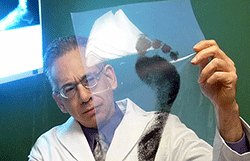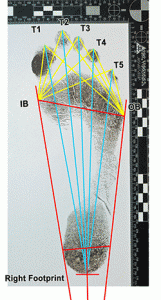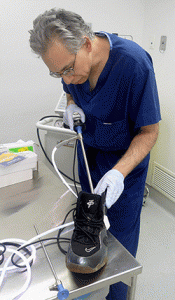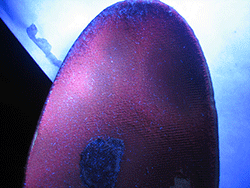Despite a thief donning two pairs of pants, a mask, and gloves when he robbed a jewelry store at gunpoint, he was unable to hide how he walked. Cameras in the store recorded the thief, and, by comparing the perpetrator’s gait with that of surveillance video of the suspect, a forensic podiatrist was able to give testimony in court showing the thief and the suspect were one and the same. As a result, the suspect was convicted and sentenced to prison.
The previous account is not a rare situation. Forensic podiatrists have provided assistance with hundreds of criminal cases involving video footage of criminals, footprints, and footwear, and law enforcement professionals should be aware of the scope and value of the field of forensic podiatry as a crime-fighting resource. Forensic podiatry has been defined as “the application of sound and researched podiatry knowledge and experience in forensic investigations, to show the association of an individual with a scene of crime, or to answer any other legal question concerned with the foot or footwear that requires knowledge of the functioning foot.”1
The use of foot-related evidence in criminal investigations dates back to 1862 when Jessie McLachlan’s footprint placed her at the scene of a woman’s murder for which McLachlan was subsequently convicted.2 In modern times, forensic podiatrists have assisted law enforcement in investigations since the 1970s.3
In 1989, the author published the journal article “Forensic Methods and the Podiatric Physician,” in which he suggested the need for a forensic podiatry organization.4 Forensic podiatrist John DiMaggio founded the American Society of Forensic Podiatry in 2003, and, today, the organization has 51 members. Colleges and universities, law enforcement agencies, and forensic organizations around the world, including the long-established International Association for Identification, recognize forensic podiatry as a sound and valuable asset to the field of forensic science.
However, not all podiatrists are qualified to offer forensic assistance. Podiatrists who wish to practice forensic podiatry must learn how to apply the scientific principles of podiatric medicine to forensic situations.5 Podiatrists often gain forensic competence through additional forensic-related training, education, or research beyond that required to practice non-forensic podiatry.
There are three main areas of practice within forensic podiatry, each focused primarily on providing analysis and criminal identification.
- Footprints
- Gait Analysis (on video footage)
- Footwear
Though these areas are the fundamental domains of forensic podiatrists, it’s important to note that other experts may also provide assistance in these areas.
Footprints
In Waushara County, Wisconsin, investigators discovered bloody sock-clad footprints on the floor of a motel room where Robert Kasun was murdered. The author analyzed photographs of these footprints and of the same footprints enhanced with the chemical luminol. He compared these enhanced footprints to sock-clad footprints created by the suspect, Travis Petersen, while walking and standing and provided expert testimony in court linking one of the bloody footprints from the motel room to Petersen’s footprint.6 The jury convicted Petersen, and he received a sentence of life without parole.
Although footprints have not been proven to be unique, research shows that their evidentiary value is strong. Since the 1990s, Sergeant Robert Kennedy of the Royal Canadian Mounted Police (RCMP) has led research that has collected and analyzed 24,000 footprints, finding each to be different.7 Further, statistical analysis of the footprint data collected by Sergeant Kennedy has found “the odds of a chance match” for a footprint in the general population is one in 1.27 billion.8 Given the distinctiveness of footprints, finding commonality and relationships between compared footprints allows for the conclusion that the same person could have made the footprints.
Investigators should be aware that footprints may not be readily apparent at a crime scene, and those that do exist may not be on the floor. Footprints can be found on countertops, chairs, or even on victims themselves, both on their clothing or in the form of bruises. To make footprints visible, investigators may need to examine surfaces with oblique lighting with the crime scene darkened or may need to use chemicals, such as amido black, or an electrostatic detector device.
Once a footprint is discovered, it should be photographed. Photographs should include a ruler to show scale, and the camera should be positioned parallel to the plane of the footprint. Positioning light sources at oblique angles to a footprint may enhance its visibility. Footprints that have three-dimensional qualities, such as those made in sand or mud, should be cast after they have been photographed. When possible, investigators should seize the footprint and the surface it is on, so it is available for analysis later.
A key tenet of forensic podiatry is to generally employ two different methods of footprint examination when comparing a crime scene footprint to a suspect’s footprint. These two methods are the overlay approach and a linear measurement methodology.9
The overlay approach considers the morphology of the crime scene footprint and the suspect’s footprint. Some of these aspects of the footprints may include the position, shape, and contour of the toes and the overall shape of the footprints. For this comparison, the forensic podiatrist may use low-tech methods, such as “cut outs,” outlines, and overlays on clear acetate, as well as high-tech digital methods, such as imaging software.10

The linear measurement approach considers the distance and/or angles between reference points on the crime scene footprint and compares these measurements with the same measures on the suspect’s footprint.11

Other aspects of footprint analysis and comparison may include the following:
Pathology evaluation: Forensic podiatrists’ extensive foot and ankle training makes them ideally suited to evaluate footprints for the presence or absence of pathology, which may be structural, dermatologic, or related to biomechanics.
Absence or presence of expected or unexpected features: The absence of features on a footprint may be due to anatomical variation, biomechanics, or other factors. For example, in the Waushara case described above, the impression that would typically be made by the foot’s baby toe was missing from the crime scene footprint and the suspect’s footprint. The consistency of the absence of the baby toe impression was an important aspect of the footprint comparison process.
Surface considerations: Footprint features result from the foot interacting with the surface beneath it, and analysis requires consideration of the surface’s texture, pliability, and slope (if any). As an illustration, the author provided analysis in the murder of Susan Smith of Bothell, Washington, where a bloody footprint was found on a toddler’s foam play mat in Smith’s home. The effect of the perpetrator’s foot depressing or “sinking” into the mat when creating the footprint versus the differences in the suspect’s footprint created while walking on a concrete floor (non-pliable surface) had to be taken into consideration during the forensic analysis.12
Gait Analysis
The increasing use of video surveillance or closed circuit television (CCTV) suggests a greater likelihood that criminals will be recorded committing crimes or while they are departing or arriving from the scene of the crime. However, investigators who observe a criminal walking or running on video may not be able to make an identification by facial features, which may be obscured by poor lighting, inadequate camera angles, the use of a mask, and other factors. In these circumstances, a forensic podiatrist may be able to link a suspect to the criminal act by analysis and comparison of his or her gait.
Gait is said to refer to the “manner or style of walking.”13 More specifically, gait is the way humans (and certain animals, such as horses) move, an essential component of which is the repetitive nature of the movement.14 While walking refers to one specific manner of locomotion, gait refers to both walking and running.
The examination of gait in humans can be traced to the time of Aristotle (382–322 BCE); however, it was not until the Renaissance that Giovanni Borelli (1608–1679) performed the first truly scientific gait analysis experiments.15 Forensic gait analysis has been described as “the recognition and comparison of gait and features of gait, to assist in the process of identification.”16 The use of forensic gait analysis has successfully shown commonality (or a lack thereof) between a perpetrator and a suspect.
To utilize forensic gait analysis for a case, investigators must have identified a suspect and, prior to making an arrest, surveillance video of the suspect should be obtained. Investigators should consider discussing the case with a forensic podiatrist who has expertise in forensic gait analysis to help determine the best way to videotape the suspect. In general, surveillance video of a suspect should be shot at various angles, taking care to include the angle that most closely approximates the camera angle of the surveillance video that recorded the offender. If possible, the suspect should also be moving at a similar speed as the offender was in the recording.
Once investigators have shot surveillance video of the suspect, the forensic podiatrist can then analyze it and compare it with video of the criminal. The specific features and characteristics of the gait of the suspect and the individual in the surveillance video are compared for similarities and differences with regard to motions, positions, and structure.17
Footwear
Perpetrators may leave footwear at a crime scene for a variety of reasons. For example, to avoid getting blood on their shoes, the criminal may remove them prior to committing the crime. The criminal also may remove his shoes to undress in order to rape a victim.
On December 19, 2012, Travis Newby of Smithfield, Virginia, returned home to find a thief in his apartment. The perpetrator, Shymeek Stanfield, wrestled with Newby, and then shot him dead before he fled. During the struggle, one of Stanfield’s shoes fell off and was left at the crime scene. The author provided expert forensic podiatry evidence in court that linked Stanfield to the shoe left at the scene. Stanfield was convicted and sentenced to 35 years in prison.18
The best way for an investigator to determine if a suspect wore a shoe found at a crime scene is to compare the shoe at the crime scene with one known to belong to the suspect. Often, the suspect will have shoes on when he or she is arrested that can be used. When possible, a suspect’s shoe used in the comparison process should be of similar style and type as the crime scene shoe. The objective of shoe comparison, of course, is to determine if the same person did (or did not) wear the shoes found at a crime scene.
Forensic podiatry examination of a shoe found at the crime scene and a shoe confirmed as belonging to (and worn by) a suspect includes analysis and comparison of the wear pattern on the shoe outsoles, the inside of the shoes, the uppers of the shoes (inside and out), and the insoles. During the examination, shoes may be photographed internally with a fiber-optic camera, and, eventually, they are carefully disassembled to facilitate analysis of the shoes’ internal components.19

The manufacturer’s tags on the inside of the shoes should also be considered, as this may provide information about sizing, manufacturer, and shoe style.
With regard to shoe sizing, the U.S. shoe sizing system as a general guideline uses increments of 1/3 of an inch between sizes in terms of length; however, caution must be used when considering shoe sizes, as there can be significant variation between styles and manufacturers. Further, even a single size made by the same manufacturer may vary. Thus, shoe sizes should be considered relative to each other as size graduations only.20
Most shoe insoles will show a footprint impression made by the wearer’s foot.21 Like footprints found at crime scenes, footprints on shoe insoles may need enhancement to make them more visible. To enhance insole footprints, photography with oblique lighting or alternate light sources, such as ultraviolet (UV) light, may be used as well as digital manipulation of photographs of the footprint impression with imaging software.

A footprint on the insole of a shoe represents the relationship of the foot interacting with the insole over time, as opposed to a footprint found on a surface that occurs in what may be considered an instant of time.22 Thus, the effect of the shoe on the foot and the foot on the shoe needs to be considered when analysing footprint impressions on insoles.
An approach to the examination of the footprints on insoles involves the recording of the footprint impressions on the insoles from the suspect shoe and the insole of the shoe from the crime scene through photography, transfer or tracing of the footprint impressions onto clear acetate sheets, and digital capture. The footprint impressions on the insoles of the shoes are compared by employing the previously described footprint analysis techniques of overlay and linear measurement assessment with the caveat that the effects of the shoe on the foot (and vice versa) must be considered.
Footprints made by the suspect standing and walking may also be compared to the footprint impression on the insole of a shoe found at the crime scene. Generally though, comparison of footprint impressions on insoles shows more similarity when each footprint impression is made by the same person than when the comparison is with the suspect’s footprints on paper. Thus, shoe-to-shoe comparison is the preferred method of comparing footprint impressions on insoles.23
Other Aspects of Forensic Podiatry
Forensic podiatrists can assist with other aspects of investigation involving the foot, ankle, or related structures, gait, or footwear. Some examples include the following:
- Crime scene reconstruction: When multiple footprints are found at a crime scene, a forensic podiatrist may be able to provide insight into the perpetrator’s movement.
- Human remains identification: Forensic podiatrists have helped identify deceased persons by comparing discovered body parts related to the foot to medical records.
- Civil litigation: Forensic podiatrists can analyze fraudulent medical or injury claims. For example, forensic podiatrist Norman Gunn analyzed the wear features on a litigant’s footwear proving that the person was not wheelchair bound as had been claimed.24
Forensic podiatrists have also assisted law enforcement in less common ways. For example, in one case, a forensic podiatrist showed that the toe area of a suspect’s shoe had enough space present when worn by the suspect to hide a defined amount of cocaine.25
Conclusion
As criminals become smarter and use more tools and techniques to perpetrate crimes, law enforcement must also keep pace. This article has detailed how forensic podiatrists can help in the fight against crime. These experts have provided assistance with hundreds of criminal cases in their forensic analyses of gaits on surveillance videos and footprints and footwear found at crime scenes.
A renowned forensic scientist has said it quite well:
Wherever he steps, whatever he touches, whatever he leaves, even unconsciously, will serve as silent evidence against him. Not only his fingerprints or footprints…. This is evidence that does not forget. It is not confused by the excitement of the moment. It is not absent because human witnesses are. It is factual evidence.[emphasis in the original] Physical evidence cannot be wrong, it cannot perjure itself, it cannot be wholly absent. Only human failure to find it, study, and understand it can diminish its value.26
These words serve to highlight the importance of investigators finding and analyzing all physical evidence–including foot-related evidence.
Forensic podiatrists can provide an integral role on the law enforcement forensic team. In the quest for justice, these experts offer law enforcement professionals a powerful resource to identify criminals.♦
Notes:
1D.W. Vernon and F.J. McCourt, “Forensic Podiatry—a Review and Definition,” British Journal of Podiatry 2 (1999): 45–48.
2Judy Hamilton, “Jessie McLachlan” in Scottish Murders: From Burke and Hare to Peter Tobin (Glasgow: Waverly Scottish Classics, 2013), Kindle edition.
3 4Michael S. Nirenberg, “Forensic Methods and the Podiatric Physician,” Journal of the American Podiatric Medical Association 79, no. 5 (1989): 247–252.
5Wesley Vernon et al., “Forensic Podiatry: Role and Scope of Practice (in the context of forensic human identification),” IDentification News 40 (2010): 22–24.
6Elvia Malagon, “Crown Point Doctor Using Expertise to Help Solve Crimes,” NWI.com, December 31, 2014, http://www.nwitimes.com/news/local/lake/crown-point-doctor-using-expertise-to-help-solve-crimes/article_1dad885a-e958-5054-9b8a-fc91f93c97b2.html (accessed December 7, 2015); Michael S. Nirenberg, personal experience.
7John A. DiMaggio and Wesley Vernon, Forensic Podiatry: Principles and Methods (New York: Humana Press, 2011); Robert B. Kennedy, “Ongoing Research into Barefoot Impression Evidence” in Forensic Medicine of the Lower Extremity (New York: Humana Press, 2005), 401–413; Robert B. Kennedy, “Uniqueness of Bare Feet and Its Use as a Possible Means of Identification,” Forensic Science International 82, no. 1 (September 1996): 81–87; Robert B. Kennedy et al., “Statistical Analysis of Barefoot Impressions,” Journal of Forensic Science 48, no. 1 (January 2003): 55–63.
8Robert B. Kennedy et al., “A Large-Scale Statistical Analysis of Barefoot Impressions,” Journal of Forensic Science 50, no. 5 (September 2005): 1071–1080.
9Nirenberg, “Forensic Methods and the Podiatric Physician.”
10Ibid.
11Ibid.
12Briana Gerdeman, “Potential Witness in Murder Trial Commits Suicide,” The Woodinville Weekly, April 23, 2014, http://www.nwnews.com/index.php/local/news/9512-potential-witness-in-murder-trial-commits-suicide (accessed December 7, 2015); Michael S. Nirenberg, personal experience.
13Michael W. Whittle, Gait Analysis: An Introduction (Oxford: Butterworth-Heinemann, Ltd, 2014).
14Whittle, Gait Analysis; Ivan Birch et al., “The Identification of Individuals by Observational Gait Analysis Using Closed Circuit Television Footage,” Science & Justice 53, no. 3 (September 2013): 339–342; Ivan Birch et al., “Terminology and Forensic Gait Analysis,” Science & Justice 55, no. 4 (July 2015): 279–284.
15Richard Baker, “The History of Gait Analysis before the Advent of Modern Computers,” Gait & Posture 26, no. 3 (September 2007): 331–342.
16DiMaggio and Vernon, Forensic Podiatry.
17Ibid.; Birch et al., “Terminology and Forensic Gait Analysis.”
18Margaret Matray, “Newport News Man to Serve 35 Years for Fatal Shooting,” The Virginian-Pilot, April 30, 2015 http://www.pilotonline.com/news/local/crime/newport-news-man-to-serve-years-for-fatal-shooting/article_a8e9dfd1-b127-5621-908e-03dbb594f530.html (accessed December 7, 2015); Michael S. Nirenberg, personal experience.
19Michael S. Nirenberg, “New Method for Examining the Inside of Footwear,” Journal of Forensic Identification 58, no. 3 (2008): 297–304; DiMaggio and Vernon, Forensic Podiatry.
20DiMaggio and Vernon, Forensic Podiatry; William J. Bodziak, Footwear Impression Evidence: Detection, Recovery and Examination, 2nd ed., Practical Aspects of Criminal and Forensic Investigations (Boca Raton, FL: CRC Press, 1999).
21DiMaggio and Vernon, Forensic Podiatry.
22Ibid.
23Ibid.; Lesley Hammer et al., “Preliminary Study of the Comparison of Inked Barefoot Impressions with Impressions from Shoe Insoles Using a Controlled Population,” Journal of Forensic Identification 62, no. 6 (2011): 603–622.
24Wesley Vernon, personal communication, May 27, 2015.
25Ibid.
26Paul L. Kirk, Crime Investigation—Physical Evidence and the Police Laboratory (New York: Interscience Publishers, Inc., 1953), 2.
Please cite as
Michael Nirenberg, “Gait, Footprints, and Footwear: How Forensic Podiatry Can Identify Criminals,” The Police Chief 83 (January 2016): web only.


